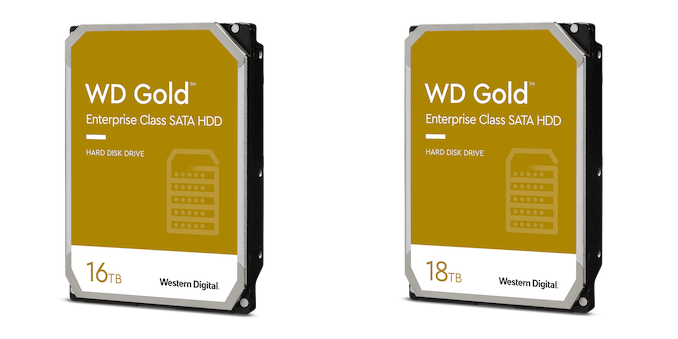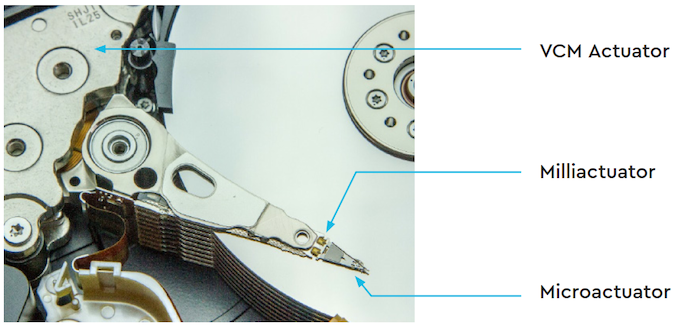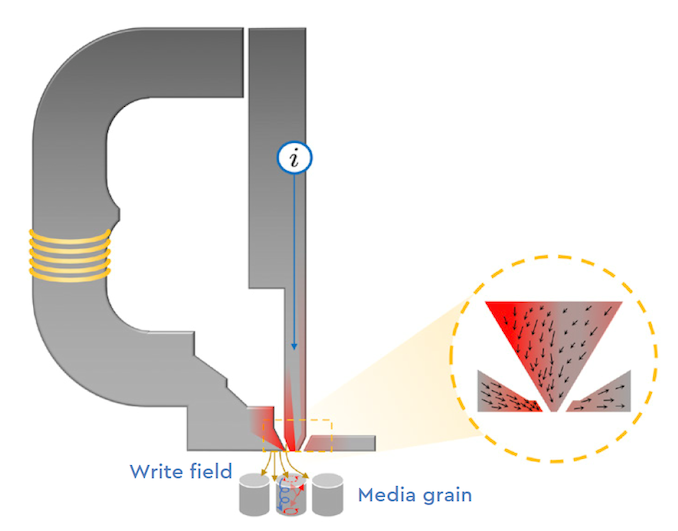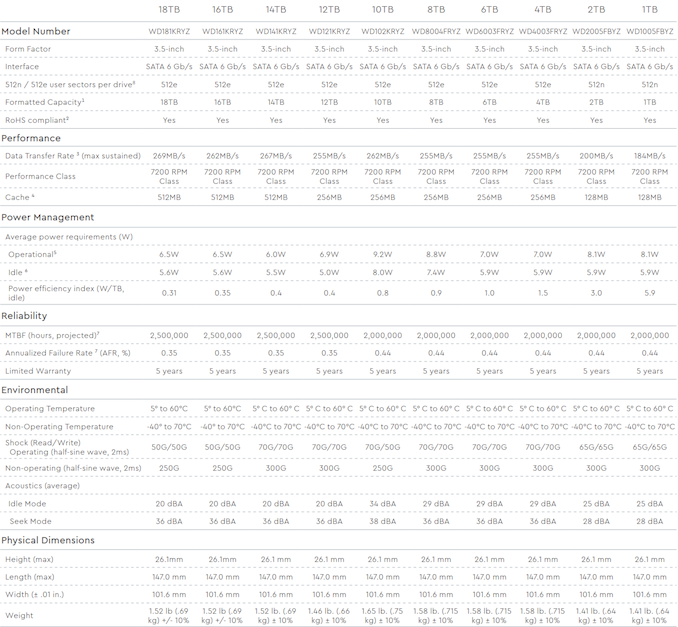Western Digital's 16TB and 18TB Gold Drives: EAMR HDDs Enter the Retail Channel
by Ganesh T S on July 9, 2020 8:00 AM EST- Posted in
- Storage
- HDDs
- NAS
- Western Digital
- MAMR
- Helium HDD
- HAMR
- CMR
- EAMR

Western Digital made a number of announcements yesterday related to their enterprise hard-disk drives (HDD) product lines. While there was nothing unexpected in terms of the products being announced, two aspects stood out - one was the retail availability of EAMR (energy-assisted magnetic recording) HDDs, and the other was additional information on the EAMR technology itself. In 2019, WD had announced the sampling of EAMR-based Ultrastar DC datacenter HDDs with 18TB and 20TB capacities. Yesterday's announcements build upon those products - the WD Gold-branded version of the Ultrastar DC CMR drives is now available for retail purchase, and the Ultrastar drives themselves have moved to general availability. The Ultrastar JBOD and storage server product lines have also been updated to utilize these new high-capacity drives.
Flash-based storage devices have taken over traditional consumer hard-drive application areas. However, increasing data storage requirements mean that HDDs still continue to be the most cost-effective solution for bulk storage. HDD vendors have been working on increasing hard drive capacities using multiple techniques. Around 10 years back, we had 2TB 3.5" HDDs with five PMR (perpendicular magnetic recording) platters in an air-filled enclosure. These drives were CMR (conventional magnetic recording) drives. In the last decade, we have seen advancements in three different categories that have enabled a 10-fold increase in the capacity of HDDs while retaining the same physical footprint:
Increasing the number of platters / making the platters thinner has been made possible by using sealed helium-filled enclosures. The reduced turbulence enables platters to be stacked closer to each other. The first-generation helium HDDs had 7 platters, and this has now grown to 9 platters for the new high-capacity drives.
The size of the writing head and the flexibility with which it can be manipulated dictate the minimum width of the recording tracks on the platters. Western Digital is claiming that they are the first to use a triple-stage actuator (TSA) in shipping HDDs.

The enhanced precision with TSA allows the TPI factor to go up. Incidentally, Seagate also has a novel actuator scheme (dual actuator), though that is aimed at increasing the throughput / IOPS.
One of the key challenges faced in the quest to increase the areal density of platters is the ability of the writing head to reliably alter the magnetic state of the grains in the tracks. Both heat-assisted magnetic recording (HAMR) and microwave-assisted magnetic recording (MAMR) are techniques that address this issue. In 2017, WD seemed set to go all-in on MAMR for their HDD product line, but three years down the road, we are looking at a variant that WD claims is a product of their HAMR and MAMR research - EAMR (energy-assisted magnetic recording).
While details were scant when EAMR was announced , WD is finally opening up on some of the technical aspects.

WD's first-generation EAMR technology (christened as ePMR) involves the application of electrical current to the writing head's main pole (this is in addition to the current sent through the voice coil) during write operations. The additional magnetic field created by this bias current ensures that the bits on the track alter their state in a more deterministic manner. In turn, this allows the bits to be packed closer together and increasing the areal density.
The above techniques can also be used with shingled magnetic recording (SMR) to boost areal density further. SMR has been around in both host-managed and drive-managed versions for a few years now. WD indicated in yesterday's announcement that qualification shipments of their 20TB Ultrastar DC host-managed SMR drive are in progress.

The WD Gold 18TB is available for purchase today and will set you back by $593. The 16TB version is priced at $528, but is currently out of stock. As is typical for enterprise drives, the two new models each have a MTBF of 2.5M hours, workload rating of 550TB/yr, and a 5 year warranty.
Source: Western Digital










69 Comments
View All Comments
Deicidium369 - Thursday, July 9, 2020 - link
WD Gold WD181KRYZ 18TB 7200 RPM 512MB Cache SATA 6.0Gb/s 3.5" Internal Hard Drive $593 - the drive listed in the article. Price from NewEgg.DigitalFreak - Friday, July 10, 2020 - link
Nah, he just likes to throw around the latest buzzphrase to act like he's cool or something.MrSpadge - Thursday, July 9, 2020 - link
You could nitpick that in 2010 the first 3 TB drives were released. But calling this "Fake News" is just wrong. Fake News is what Trump does: to just plain lie and make up things. But ever since humans started to speak, they tended to present information in misleading ways, by leaving things out or implying wrong context. That's not fake, because what is being said is wrong.So if you want you can accuse AT of misleading the reader by not mentioning the fabrication cost increase. IMO that's still absolutely not justified, because the article simply does not talk about cost. Would they have wanted to mislead there would be chatchy phrases about the cost per GB going down or something like that.
dullard - Thursday, July 9, 2020 - link
Since these drives are enterprise drives, lets look a enterprise drives from 10 years ago in a 2 TB drive review:https://hothardware.com/reviews/definitive-2tb-har...
"All three enterprise drives are the most-expensive ones in the roundup, ranging in price from $290 up to $318."
So, yes the price went up from ~$300 to ~$593.
The price per TB went from $150/TB to $33/TB. We get a 9-fold increase in capacity. We get a 4.5-fold decrease in $/TB. We get a doubling of the rated mean time between failures. We get lower idle and lower operating power usage. We get 8-fold increase in cache. We get a 2.5-fold increase in sustained data transfer rate.
vFunct - Thursday, July 9, 2020 - link
So, a little bit more than inflation.nicolaim - Thursday, July 9, 2020 - link
It's way more than inflation, but as npz mentions below, Seagate 16 TB drives retail for $382.eastcoast_pete - Thursday, July 9, 2020 - link
Aren't those SMR (shingled) drives? This one here is supposedly CMR with some form of heat assist, but I agree that the price is still a bit steep. I am actually more concerned about the longevity of the drive platters themselves with all that spot heating during writes. That might be just fine for cold storage, but not sure just how the platters themselves would hold up with plenty of writes/rewrites. The refusal of WD to tell us what energy-assisted really means doesn't help to build confidence.cjl - Thursday, July 9, 2020 - link
No, at least the Exos and IronWolf 16TB drives are all CMR, not SMR.eastcoast_pete - Saturday, July 11, 2020 - link
If so, I'll give them another look. Could use a couple of 16 TB CMR drives.name99 - Thursday, July 9, 2020 - link
Since NO-ONE -- not anandtech, not WD, claimed that the drives were in any way cheaper than (or even the same price as) the top of the line ten years ago, so what?We seem to have moved onto the next stage of internet outrage where, if you can't find something to be angry about in the article, get angry at a claim that no-one involved with the article ever made.